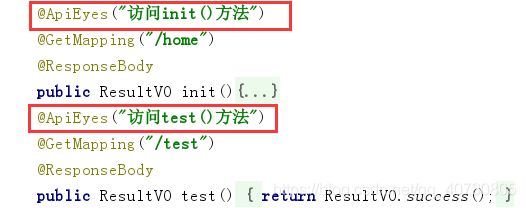- LocalDateTime 转 String
igotyback
java开发语言
importjava.time.LocalDateTime;importjava.time.format.DateTimeFormatter;publicclassMain{publicstaticvoidmain(String[]args){//获取当前时间LocalDateTimenow=LocalDateTime.now();//定义日期格式化器DateTimeFormatterformat
- Spring Boot中实现跨域请求
BABA8891
springboot后端java
在SpringBoot中实现跨域请求(CORS,Cross-OriginResourceSharing)可以通过多种方式,以下是几种常见的方法:1.使用@CrossOrigin注解在SpringBoot中,你可以在控制器或者具体的请求处理方法上使用@CrossOrigin注解来允许跨域请求。在控制器上应用:importorg.springframework.web.bind.annotation.
- Java面试笔记记录6
今天背八股了吗
java面试笔记
1.Spring是什么?特性?有哪些模块?Spring是一个轻量级、非入侵式的控制反转Ioc和面向切面AOP的框架。特性:1.Ioc和DISpring的核心就是一个大的工厂容器,可以维护所有对象的创建和依赖关系,Spring工厂用于生成Bean,并且管理Bean的生命周期,实现高内聚低耦合的设计理念。2.AOP编程Spring提供面向切面编程,可以方便实现对程序进行权限拦截、运行监控等切面功能。3
- Lombok:Java开发者的代码简化神器【后端 17】
终末圆
Java后端java开发语言mysql数据库后端springbootpython
Lombok:Java开发者的代码简化神器在Java开发中,我们经常需要编写大量的样板代码,如getter、setter、equals、hashCode、toString等方法。这些代码虽然基础且必要,但往往占据了大量开发时间,且容易在属性变更时引发错误。幸运的是,Lombok这个Java库通过注解的方式,为我们提供了一种高效的解决方案。本文将详细介绍Lombok的使用及其优势。什么是Lombok
- Spring @Async 深度解读:默认线程池执行器的配置与优化
小码快撩
springjava前端
在Spring中,@Async注解用于异步执行方法。默认情况下,@Async注解的任务是由一个线程池执行的。然而,这个默认的线程池是如何初始化的呢?本文将深入探讨这一过程,帮助你理解Spring异步任务背后的线程池执行器的初始化原理。1.@Async的基本使用首先,让我们快速回顾一下@Async的基本用法。@Async通常用于标注在需要异步执行的方法上,比如:@Servicepublicclass
- 深入理解AOP(面向切面编程)及其应用
自身就是太阳
java开发语言spring
目录AOP的核心概念AOP的实现方式1.定义DAO接口和实现类2.定义通知类3.开启AOP注解驱动切入点表达式通配符的使用:AOP通知类型案例分析:测量业务层接口的执行效率结论概述:AOP(Aspect-OrientedProgramming,面向切面编程)是一种编程范式,主要用于将共性功能从具体的业务逻辑中分离出来,实现松耦合的代码设计。其作用是在不修改原始代码的情况下,对现有方法进行增强,广泛
- Python静态方法@staticmethod和类方法@classmethod
西北小生_
Python静态方法@staticmethod和类方法@classmethod经常出现在类的定义中,二者和常规实例方法之间有什么区别呢?先看例子:classA:cnt=0val=1def__init__(self,cnt=0,val=1):self.val=valA.cnt+=1defnormal_fun(self,x):print(x+self.val)@classmethoddefget_cn
- SpringSecurity初学总结
weixin_66442229
spring
springSecurity安全框架基于Java的安全框架主要有:SpringSecurity和Shiro介绍基础概念安全框架是对用户访问权限的控制,保证应用的安全性。其主要的工作是用户认证和用户授权|鉴权主要应用于Spring的企业应用系统,提供声明式的安全访问控制解决方案。它提供了一组可以在Spring应用上下文中配置的Bean能很好的结合Spring的DI依赖注入和AOP面向切面编程功能应用
- Open Feign 实战笔记
自强-X
spring-cloudjavaspring微服务ribbonspringcloud
OpenFeign笔记概念声明式的web服务客户端。使用接口加注解的形式编程。它是对RestTemplate和ribbon做了进一步封装。Feign已经停更,OpenFeign是在Feign的基础上又做了进一步的封装。Feign:Feign是SpringCloud组件中的一个轻量级RESTful的HTTP服务客户端Feign内置了Ribbon,用来做客户端负载均衡,去调用服务注册中心的服务。Fei
- 计算机信息管理本科自考选题推荐
李哥讲程序开发
javaspringboot开发语言
计算机信息管理专业是一个跨学科的领域,它结合了计算机技术与管理技术,旨在利用计算机完成各类信息管理。以下是一些推荐的自考选题方向:基于SSM的毕业设计管理系统的设计与实现基于SSM大学生校园兼职论坛管理系统基于SSM的家教应聘招聘系统的设计和实现基于SpringBoot住院患者满意度跟踪调查系统的设计与实现基于SpringBoot在线作业提交系统的设计与实现总的来说,这些建议的选题方向覆盖了计算机
- 《Android进阶之光》— Android 书籍
王睿丶
Android永无止境《Android进阶之光》Android书籍Androidphoenix移动开发
文章目录第1章Android新特性1第2章MaterialDesign48第3章View体系与自定义View87第4章多线程编程165第5章网络编程与网络框架204第6章设计模式271第7章事件总线308第8章函数响应式编程333第9章注解与依赖注入框架382第10章应用架构设计422第11章系统架构与MediaPlayer框架460出版年:2017-7简介:《Android进阶之光》是一本And
- netty-简易聊天
2401_84046645
程序员java开发语言
publicvoidsend(Stringtext){channel.writeAndFlush(Unpooled.copiedBuffer(text.getBytes()));}publicvoidcloseConnect(){send(“bye”);channel.close();}}classMyHandlerextendsChannelInboundHandlerAdapter{@Over
- MyBatis 如何将 Mapper 接口与其 XML 映射文件关联:深入原理与实现
OEC小胖胖
web后端mybatisxmljavaweb后端
MyBatis如何将Mapper接口与其XML映射文件关联:深入原理与实现1.概述MyBatis是一个简单、灵活的持久层框架,它通过SQL语句将Java对象与数据库进行映射。MyBatis支持基于XML和注解的配置方式。在实际开发中,XML映射文件与Mapper接口的关联是MyBatis的核心功能之一。通过这种关联,开发者可以在Mapper接口中定义方法,并在XML文件中编写SQL语句,从而实现数
- springboot+mybatisplus实现基本的增删改查以及分页查询。这里使用的是Restful风格包括简单描述Restful是什么
okchan666
springbootjava
先实现springboot+mybatisplus的增删改查接口使用postman测试:第一步创建项目导入依赖:直接给大家了:4.0.0org.springframework.bootspring-boot-starter-parent2.6.6com.okchanspringboot_07_ssmp0.0.1-SNAPSHOT1.8org.springframework.bootspring-b
- 基于Google authentic实现的双因子登录认证系统前后台基于SSMP+Vue+Element(解决SecureRandom造成的服务器请求缓慢)
Tate_Brown
gitJAVAIDEADEBUGVUE
用md5两次加盐密码,可以灵活更换算法--直接上代码地址:JAVA后台:https://github.com/TateBrownJava/TwoFALogindemoBackendVue前端:https://github.com/TateBrownJava/TwoFALoginDemofrontend-------------------------------------------------
- Java之String类
不互关就取关
javapython开发语言
一、String类常用方法1.引用类型的比较我们知道在Java中两个引用遍历是不能用"=="号来比较的,而String类重写了父类objects的equals方法,实现了引用类型的比较例子importjava.util.Scanner;publicclassMain{publicstaticvoidmain(String[]args){Stringstr1="helloworld";Strings
- MyBatis 方法重载的陷阱及解决方案
molashaonian
mybatis方法重载异常方法名相同
在使用MyBatis进行开发时,尤其是使用注解模式(如@Select、@Insert等)时,开发者常常会遇到这样一个问题:为什么我的方法重载不能正常工作?即使在Java中允许方法名相同但参数不同的重载,MyBatis在处理注解的SQL方法时却并不支持这种方式。这篇文章将深入探讨MyBatis的这个特性及如何规避相关的坑。问题背景在标准的Java开发中,方法重载是一种常见的设计模式。方法重载允许我们
- JavaSE:4、流程控制
_Power_Y
JavaSEjava算法开发语言
1、代码块与作用域变量的使用范围,仅限于其定义时所处的代码块,也就是他的作用域。目前所说的变量均为局部变量publicclassMain{publicstaticvoidmain(String[]argv){inta=10;{intb=10;System.out.println(a);System.out.println(b);}System.out.println(a);//System.out
- python基于django/flask的NBA球员大数据分析与可视化python+java+node.js
QQ_511008285
pythondjangoflaskjavaspringboot数据分析
前端开发框架:vue.js数据库mysql版本不限后端语言框架支持:1java(SSM/springboot)-idea/eclipse2.Nodejs+Vue.js-vscode3.python(flask/django)--pycharm/vscode4.php(thinkphp/laravel)-hbuilderx数据库工具:Navicat/SQLyog等都可以本文针对NBA球员的大数据进行
- Java基于spring boot的国产电影数据分析与可视化python+java+node.js
QQ_511008285
javaspringboot数据分析pythondjangovue.jsflask
前端开发框架:vue.js数据库mysql版本不限后端语言框架支持:1java(SSM/springboot)-idea/eclipse2.Nodejs+Vue.js-vscode3.python(flask/django)--pycharm/vscode4.php(thinkphp/laravel)-hbuilderx数据库工具:Navicat/SQLyog等都可以 该系统使用进行大数据处理和
- SpringBoot—集成AOP详解(面向切面编程Aspect)
Hughman
AOP介绍AOP概述 AOP是Aspect-OrientedProgramming,即为面向(切面)方面编程。在维基百科中的解释:Aspect是一种新的模块化机制,用来描述分散在对象、类或函数中的横切关注点。从关注点中分离出横切关注点是面向切面的程序设计核心概念。分离关注点使得解决特定领域问题的代码从业务逻辑中独立出来,业务逻辑代码不需要再包含针对特定领域问题代码的调用,比如一些公用模块的日志、
- 【Java实战】使用自定义注解实现参数校验详解
.猫的树
【Java实战】系列java自定义注解参数校验
文章目录前言一、Java注解简介二、启用注解校验1.启用注解2.注解@Valid和@Validated2.1@Valid级联校验2.2@Validated高级使用三、自定义注解1.统一异常处理2.编写注解2.1自定义校验2.2多参数校验2.3列表校验总结前言由于实际开发中遇到大量相同的条件参数验证,不想写重复代码及让代码看起来更加优雅简洁,所以决定使用自定义注解进行参数校验一、Java注解简介Ja
- java常用校验注解
Bee.F
javajava
1、值校验@NotNull注解被注解的元素必须不为空,一般用于数值类型的参数校验。@NotNull(message="用户编号不能为空")privateIntegeruserId;@NotBlank注解验证注解的元素值不为空(不为null、去除首位空格后长度为0),并且类型为String。@NotBlank(message="用户名称不能为空")privateStringuserName;@Not
- [附源码]SSM计算机毕业设计游戏账号交易平台JAVA
计算机程序源码
java游戏mysql
项目运行环境配置:Jdk1.8+Tomcat7.0+Mysql+HBuilderX(Webstorm也行)+Eclispe(IntelliJIDEA,Eclispe,MyEclispe,Sts都支持)。项目技术:SSM+mybatis+Maven+Vue等等组成,B/S模式+Maven管理等等。环境需要1.运行环境:最好是javajdk1.8,我们在这个平台上运行的。其他版本理论上也可以。2.ID
- JAVA常用校验注解
小卡车555
java
引入依赖org.springframeworkspring-boot-starter-validation2.6.13相关注解及使用说明注解描述@AssertFalse所注解的元素必须是Boolean类型,且值为false@AssertTrue所注解的元素必须是Boolean类型,且值为true@DecimalMin验证Number和String对象是否大于等于指定的值,支持小数@DecimalM
- 枚举,注解
柴...
韩顺平学习java开发语言
自定义类实现枚举1.不需要提供setXxx方法,因为枚举对象值通常为只读2.对枚举对象/属性使用final+static共同修饰,实现底层优化3.枚举对象名通常使用全部大写,常量的命名规范(XXX_XXX)4.枚举对象根据需要,也可以有多个属性packagechapter;publicclassEnum{publicstaticvoidmain(String[]args){System.out.p
- 尤占芳 焦点网络初级九期 洛阳 坚持原创分享第39天 (2018-4-4星期三)
尤占芳
今天心里特别乱,被别人侵犯真的很不舒服,我要做一个学会拒绝别人的人,不能老是被别人绑架。我觉得我活的好累、好累、好累……今天就复习一下吧,真的应修整一下自己了。关注正向、关注解决、关注现在与未来、关注成功经验、关注一小步的行动。
- 【保姆级】使用Java注解和反射实现JSON字段自动重命名
AQin1012
Java出坑必备~java注解后端开发语言
不知道有没有同学遇到过对接业务方代码非常“独具一格”(不符合通用规范且不愿意配合修改emmmm。。。),于是就只能“被迫”按他的格式来,但是又不想因为他的不规范导致我们自己创建的接收对象也非常的“一言难尽”。。。今天这篇帮你解决这个问题~(老规矩:附完整可执行代码)先给初学Java的同学补下基础,涉及到一些实现这个功能需要的知识点(了解的朋友可以直接跳过~)Java注解(Annotation)Ja
- 33. MyBatis中的@Param注解如何使用?如何在Mapper接口中传递多个参数?
这孩子叫逆
Mybatis笔记javamybatistomcat
在MyBatis中,@Param注解用于将方法参数绑定到SQL语句中的命名参数。它主要用于在Mapper接口中传递多个参数,以便在SQL语句中更方便地引用这些参数。为什么使用@Param注解?在MyBatis中,当Mapper接口的方法只有一个参数时,MyBatis会默认将这个参数的名称绑定为#{parameter},可以直接在SQL语句中引用它。如果方法有多个参数,MyBatis默认使用para
- Python+Django毕业设计校园易购二手交易平台(程序+LW+部署)
Python、JAVA毕设程序源码
课程设计javamysql
项目运行环境配置:Jdk1.8+Tomcat7.0+Mysql+HBuilderX(Webstorm也行)+Eclispe(IntelliJIDEA,Eclispe,MyEclispe,Sts都支持)。项目技术:SSM+mybatis+Maven+Vue等等组成,B/S模式+Maven管理等等。环境需要1.运行环境:最好是javajdk1.8,我们在这个平台上运行的。其他版本理论上也可以。2.ID
- springmvc 下 freemarker页面枚举的遍历输出
杨白白
enumfreemarker
spring mvc freemarker 中遍历枚举
1枚举类型有一个本地方法叫values(),这个方法可以直接返回枚举数组。所以可以利用这个遍历。
enum
public enum BooleanEnum {
TRUE(Boolean.TRUE, "是"), FALSE(Boolean.FALSE, "否");
- 实习简要总结
byalias
工作
来白虹不知不觉中已经一个多月了,因为项目还在需求分析及项目架构阶段,自己在这段
时间都是在学习相关技术知识,现在对这段时间的工作及学习情况做一个总结:
(1)工作技能方面
大体分为两个阶段,Java Web 基础阶段和Java EE阶段
1)Java Web阶段
在这个阶段,自己主要着重学习了 JSP, Servlet, JDBC, MySQL,这些知识的核心点都过
了一遍,也
- Quartz——DateIntervalTrigger触发器
eksliang
quartz
转载请出自出处:http://eksliang.iteye.com/blog/2208559 一.概述
simpleTrigger 内部实现机制是通过计算间隔时间来计算下次的执行时间,这就导致他有不适合调度的定时任务。例如我们想每天的 1:00AM 执行任务,如果使用 SimpleTrigger,间隔时间就是一天。注意这里就会有一个问题,即当有 misfired 的任务并且恢复执行时,该执行时间
- Unix快捷键
18289753290
unixUnix;快捷键;
复制,删除,粘贴:
dd:删除光标所在的行 &nbs
- 获取Android设备屏幕的相关参数
酷的飞上天空
android
包含屏幕的分辨率 以及 屏幕宽度的最大dp 高度最大dp
TextView text = (TextView)findViewById(R.id.text);
DisplayMetrics dm = new DisplayMetrics();
text.append("getResources().ge
- 要做物联网?先保护好你的数据
蓝儿唯美
数据
根据Beecham Research的说法,那些在行业中希望利用物联网的关键领域需要提供更好的安全性。
在Beecham的物联网安全威胁图谱上,展示了那些可能产生内外部攻击并且需要通过快速发展的物联网行业加以解决的关键领域。
Beecham Research的技术主管Jon Howes说:“之所以我们目前还没有看到与物联网相关的严重安全事件,是因为目前还没有在大型客户和企业应用中进行部署,也就
- Java取模(求余)运算
随便小屋
java
整数之间的取模求余运算很好求,但几乎没有遇到过对负数进行取模求余,直接看下面代码:
/**
*
* @author Logic
*
*/
public class Test {
public static void main(String[] args) {
// TODO A
- SQL注入介绍
aijuans
sql注入
二、SQL注入范例
这里我们根据用户登录页面
<form action="" > 用户名:<input type="text" name="username"><br/> 密 码:<input type="password" name="passwor
- 优雅代码风格
aoyouzi
代码
总结了几点关于优雅代码风格的描述:
代码简单:不隐藏设计者的意图,抽象干净利落,控制语句直截了当。
接口清晰:类型接口表现力直白,字面表达含义,API 相互呼应以增强可测试性。
依赖项少:依赖关系越少越好,依赖少证明内聚程度高,低耦合利于自动测试,便于重构。
没有重复:重复代码意味着某些概念或想法没有在代码中良好的体现,及时重构消除重复。
战术分层:代码分层清晰,隔离明确,
- 布尔数组
百合不是茶
java布尔数组
androi中提到了布尔数组;
布尔数组默认的是false, 并且只会打印false或者是true
布尔数组的例子; 根据字符数组创建布尔数组
char[] c = {'p','u','b','l','i','c'};
//根据字符数组的长度创建布尔数组的个数
boolean[] b = new bool
- web.xml之welcome-file-list、error-page
bijian1013
javaweb.xmlservleterror-page
welcome-file-list
1.定义:
<welcome-file-list>
<welcome-file>login.jsp</welcome>
</welcome-file-list>
2.作用:用来指定WEB应用首页名称。
error-page1.定义:
<error-page&g
- richfaces 4 fileUpload组件删除上传的文件
sunjing
clearRichfaces 4fileupload
页面代码
<h:form id="fileForm"> <rich:
- 技术文章备忘
bit1129
技术文章
Zookeeper
http://wenku.baidu.com/view/bab171ffaef8941ea76e05b8.html
http://wenku.baidu.com/link?url=8thAIwFTnPh2KL2b0p1V7XSgmF9ZEFgw4V_MkIpA9j8BX2rDQMPgK5l3wcs9oBTxeekOnm5P3BK8c6K2DWynq9nfUCkRlTt9uV
- org.hibernate.hql.ast.QuerySyntaxException: unexpected token: on near line 1解决方案
白糖_
Hibernate
文章摘自:http://blog.csdn.net/yangwawa19870921/article/details/7553181
在编写HQL时,可能会出现这种代码:
select a.name,b.age from TableA a left join TableB b on a.id=b.id
如果这是HQL,那么这段代码就是错误的,因为HQL不支持
- sqlserver按照字段内容进行排序
bozch
按照内容排序
在做项目的时候,遇到了这样的一个需求:
从数据库中取出的数据集,首先要将某个数据或者多个数据按照地段内容放到前面显示,例如:从学生表中取出姓李的放到数据集的前面;
select * fro
- 编程珠玑-第一章-位图排序
bylijinnan
java编程珠玑
import java.io.BufferedWriter;
import java.io.File;
import java.io.FileWriter;
import java.io.IOException;
import java.io.Writer;
import java.util.Random;
public class BitMapSearch {
- Java关于==和equals
chenbowen00
java
关于==和equals概念其实很简单,一个是比较内存地址是否相同,一个比较的是值内容是否相同。虽然理解上不难,但是有时存在一些理解误区,如下情况:
1、
String a = "aaa";
a=="aaa";
==> true
2、
new String("aaa")==new String("aaa
- [IT与资本]软件行业需对外界投资热情保持警惕
comsci
it
我还是那个看法,软件行业需要增强内生动力,尽量依靠自有资金和营业收入来进行经营,避免在资本市场上经受各种不同类型的风险,为企业自主研发核心技术和产品提供稳定,温和的外部环境...
如果我们在自己尚未掌握核心技术之前,企图依靠上市来筹集资金,然后使劲往某个领域砸钱,然
- oracle 数据块结构
daizj
oracle块数据块块结构行目录
oracle 数据块是数据库存储的最小单位,一般为操作系统块的N倍。其结构为:
块头--〉空行--〉数据,其实际为纵行结构。
块的标准大小由初始化参数DB_BLOCK_SIZE指定。具有标准大小的块称为标准块(Standard Block)。块的大小和标准块的大小不同的块叫非标准块(Nonstandard Block)。同一数据库中,Oracle9i及以上版本支持同一数据库中同时使用标
- github上一些觉得对自己工作有用的项目收集
dengkane
github
github上一些觉得对自己工作有用的项目收集
技能类
markdown语法中文说明
回到顶部
全文检索
elasticsearch
bigdesk elasticsearch管理插件
回到顶部
nosql
mapdb 支持亿级别map, list, 支持事务. 可考虑做为缓存使用
C
- 初二上学期难记单词二
dcj3sjt126com
englishword
dangerous 危险的
panda 熊猫
lion 狮子
elephant 象
monkey 猴子
tiger 老虎
deer 鹿
snake 蛇
rabbit 兔子
duck 鸭
horse 马
forest 森林
fall 跌倒;落下
climb 爬;攀登
finish 完成;结束
cinema 电影院;电影
seafood 海鲜;海产食品
bank 银行
- 8、mysql外键(FOREIGN KEY)的简单使用
dcj3sjt126com
mysql
一、基本概念
1、MySQL中“键”和“索引”的定义相同,所以外键和主键一样也是索引的一种。不同的是MySQL会自动为所有表的主键进行索引,但是外键字段必须由用户进行明确的索引。用于外键关系的字段必须在所有的参照表中进行明确地索引,InnoDB不能自动地创建索引。
2、外键可以是一对一的,一个表的记录只能与另一个表的一条记录连接,或者是一对多的,一个表的记录与另一个表的多条记录连接。
3、如
- java循环标签 Foreach
shuizhaosi888
标签java循环foreach
1. 简单的for循环
public static void main(String[] args) {
for (int i = 1, y = i + 10; i < 5 && y < 12; i++, y = i * 2) {
System.err.println("i=" + i + " y="
- Spring Security(05)——异常信息本地化
234390216
exceptionSpring Security异常信息本地化
异常信息本地化
Spring Security支持将展现给终端用户看的异常信息本地化,这些信息包括认证失败、访问被拒绝等。而对于展现给开发者看的异常信息和日志信息(如配置错误)则是不能够进行本地化的,它们是以英文硬编码在Spring Security的代码中的。在Spring-Security-core-x
- DUBBO架构服务端告警Failed to send message Response
javamingtingzhao
架构DUBBO
废话不多说,警告日志如下,不知道有哪位遇到过,此异常在服务端抛出(服务器启动第一次运行会有这个警告),后续运行没问题,找了好久真心不知道哪里错了。
WARN 2015-07-18 22:31:15,272 com.alibaba.dubbo.remoting.transport.dispatcher.ChannelEventRunnable.run(84)
- JS中Date对象中几个用法
leeqq
JavaScriptDate最后一天
近来工作中遇到这样的两个需求
1. 给个Date对象,找出该时间所在月的第一天和最后一天
2. 给个Date对象,找出该时间所在周的第一天和最后一天
需求1中的找月第一天很简单,我记得api中有setDate方法可以使用
使用setDate方法前,先看看getDate
var date = new Date();
console.log(date);
// Sat J
- MFC中使用ado技术操作数据库
你不认识的休道人
sqlmfc
1.在stdafx.h中导入ado动态链接库
#import"C:\Program Files\Common Files\System\ado\msado15.dll" no_namespace rename("EOF","end")2.在CTestApp文件的InitInstance()函数中domodal之前写::CoIniti
- Android Studio加速
rensanning
android studio
Android Studio慢、吃内存!启动时后会立即通过Gradle来sync & build工程。
(1)设置Android Studio
a) 禁用插件
File -> Settings... Plugins 去掉一些没有用的插件。
比如:Git Integration、GitHub、Google Cloud Testing、Google Cloud
- 各数据库的批量Update操作
tomcat_oracle
javaoraclesqlmysqlsqlite
MyBatis的update元素的用法与insert元素基本相同,因此本篇不打算重复了。本篇仅记录批量update操作的
sql语句,懂得SQL语句,那么MyBatis部分的操作就简单了。 注意:下列批量更新语句都是作为一个事务整体执行,要不全部成功,要不全部回滚。
MSSQL的SQL语句
WITH R AS(
SELECT 'John' as name, 18 as
- html禁止清除input文本输入缓存
xp9802
input
多数浏览器默认会缓存input的值,只有使用ctl+F5强制刷新的才可以清除缓存记录。如果不想让浏览器缓存input的值,有2种方法:
方法一: 在不想使用缓存的input中添加 autocomplete="off"; eg: <input type="text" autocomplete="off" name

